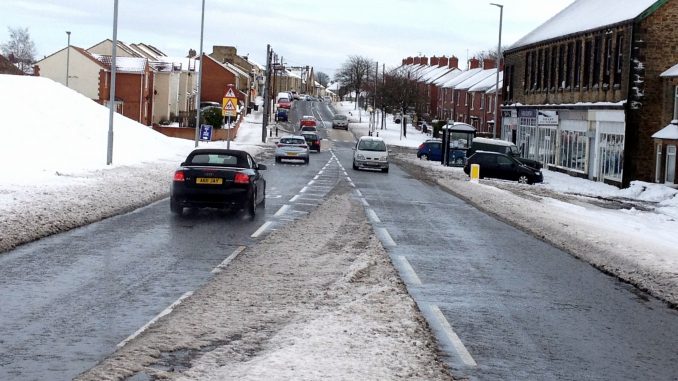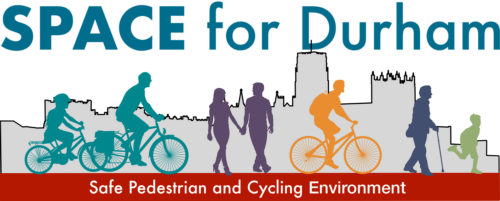
How do you deal with large numbers of drivers failing to observe a speed limit? If you are on Durham County Council’s Highways Committee, the answer is … raise the speed limit, so the drivers are no longer exceeding it and the problem disappears! This solution was recently agreed to “solve” persistent law-breaking (for this is what it is), on a new road at Leadgate near Consett.
Regular users of the National Cycle Route 7 between Consett and Stanley will be familiar with the site of the problem, because for two years the path was closed whilst Durham County Council removed the old railway bridge that took the road from Villa Real roundabout over the cycle path and into Leadgate’s Front Street. According to the Council, the work would provide a “major boost” to the local economy and save people tiresome waits at the traffic lights for the single-lane bridge.
It resulted in what was an unbroken, traffic-free link through Leadgate being replaced with a road-level crossing point, at which cyclists and pedestrians now have to give way to motorised traffic.
According to the Chronicle story at the time the work would cost £2.4m, though that was before the job over-ran by a year. (By comparison, Durham County Council’s cycling budget for 2017 for the whole county, amounts to around £300k).
However, within a year of the road re-opening, the very County engineers who designed it were back before the Highways Committee on November 20th 2017, recommending the speed limit on the new stretch of road be raised from 30mph to 40mph, because “the 30mph speed limit is not considered to be ‘self-evident’ to drivers on the new road layout with its wide carriageway, the removal of the traffic signals and the lack of property frontage development.”

Yes, that’s right, the new, straight road that Durham Highways built just a year ago was encouraging people to break the speed limit! Who would have thought it?
According to an earlier report by Brian Buckley, a Strategic Highways Manager with the Council, the police received a “significant” number of complaints about speeding on the new road, and responded with “periods of targeted police enforcement”. Surveys on the new road found that an incredible 77% of drivers were breaking the speed limit.
Rather than telling them to pay more attention to their driving, Brian Buckley told the Highways Committee that “The general consensus from the Police and motorists is that the new road layout does not warrant the current 30mph speed limit”. He referred to the 32 complaints made to the County Council in the first eight months since the road was reopened, but it is unclear how many of these were complaining about excessive speed and how many were complaints from people who had been caught speeding!
Buckley quoted DfT circular 01/2013, which states “speed limits should be evidence-led and self-explaining and seek to reinforce the driver’s assessment of what is a safe speed to travel”. He failed to quote, however, the recommendation four paragraphs further down, which says, “Traffic authorities are asked to keep their speed limits under review with changing circumstances, and to consider the introduction of more 20 mph limits and zones, over time, in urban areas and built-up village streets that are primarily residential, to ensure greater safety for pedestrians and cyclists“. (our italics)
Nor did he mention Paragraph 18, which says, “Speed limits are only one element of speed management. Local speed limits should not be set in isolation. They should be part of a package with other speed management measures including engineering and road geometry that respect the needs of all road users and raise the driver’s awareness of their environment; education; driver information; training and publicity.” In other words, Durham County Council should have managed the traffic speed at the design stage. There was no discussion at the Highways Committee of introducing a 20mph limit, or making any changes outlined in the DfT paragraph above.
The report has amazingly little detail on the original complaints that gave rise to the police enforcement, and therefore it is hard to tell whether the proposed measures will satisfy local people. Was the speeding most of concern on the stretch of the road where the housing starts, at the zebra crossing, or at the new traffic island where the C2C route crosses the new road?
Overall you cannot help feeling that if we want to achieve a calm and safe traffic environment that encourages active travel, starting with a new road with generous lane widths and copious central hatching is not a brilliant position to be in. There is a glimmer of hope, however. Paragraph 18 of the committee report mentions that relocating the start of the 30 mph zone to the point just before the cycle path crossing “will permit ‘gateway features’ to be created upon approaching the C2C crossing point” and it is explained that an additional traffic island will be built in advance of the C2C crossing. We will look at what could be achieved in a future posting.
Trust Pathways Durham has written to Durham County Council’s Highways, and to the Police and Crime Commissioner Ron Hogg, asking questions about the handling of this issue, but we’ve had no reply from either yet.
So, to return to our headline, it seems that if enough people break the speed limit, it will be raised. Therefore, these limits are not to be taken too seriously. They are advisory only.

30mph speed limit should be enforced in Bradley Bungalows: gardeners are going to their allotments, having to cross the road as traffic is speeding down, and everybody that uses the bus here has to cross the speed track.
I cycle on this route frequently and I have to assume that the council are trying to discourage cycling in the county. The cycle paths are often affected by snow or ice in winter and as they are not cleared or gritted, we now have the option of sharing the road with speeding traffic.